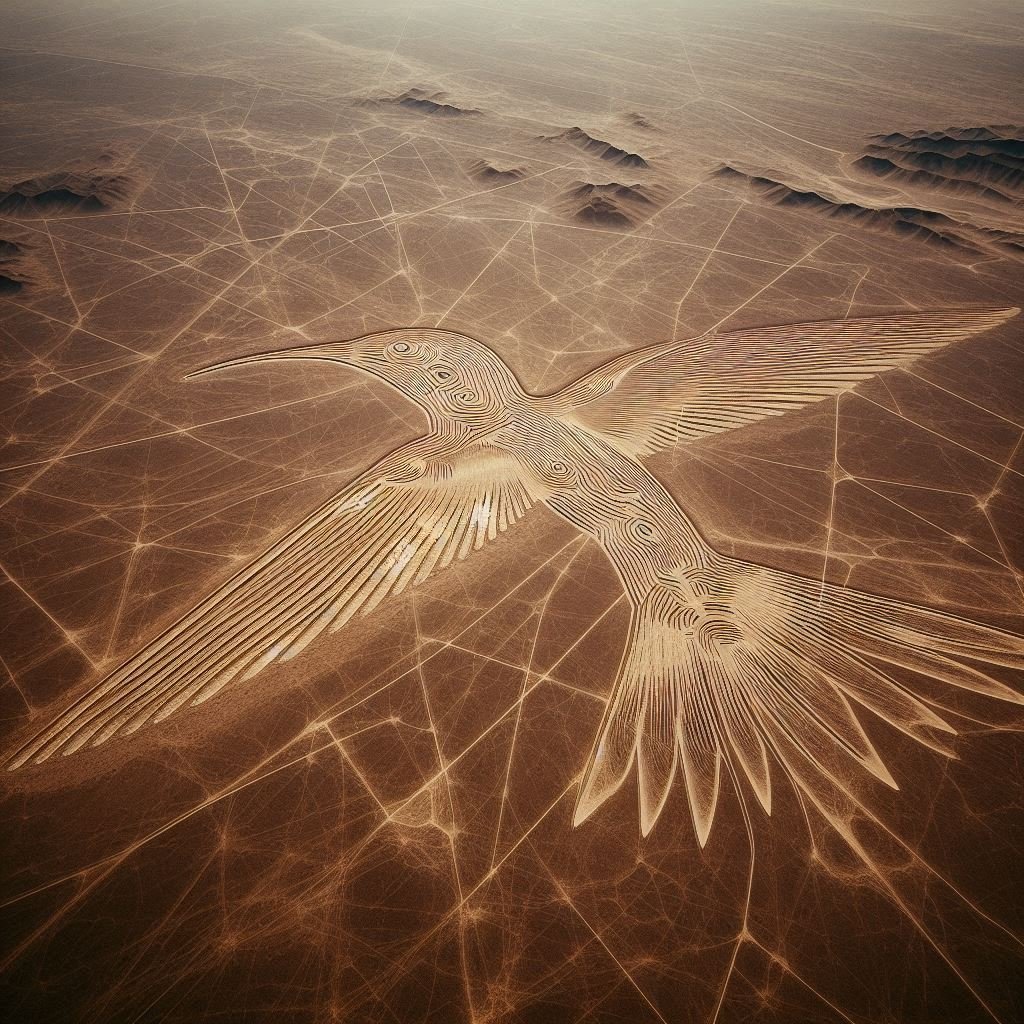Listen to “Unraveling the Mystery of the Nazca Lines” on Spreaker.
If you were standing on the ground in the southern desert of Peru, it wouldn’t look like much at first. The earth around you would be flat, endless, and bone-dry, the kind of desert where the sun feels like it’s pressing down on your skull. The landscape would stretch on forever in a faded palette of browns and reds, so empty it almost feels like the surface of another planet. Now imagine climbing into a small plane, strapping in, and taking off into that endless sky. The earth begins to shrink away beneath you. And that’s when you see them.
Lines. Enormous, perfectly straight lines. Triangles. Spirals. Huge shapes carved directly into the desert floor. And then—animals. A hummingbird with wings outstretched. A monkey with an impossibly long curly tail. A giant spider with legs so long they could crush a bus. There’s even a strange human-like figure waving back at you from the sand, its head cartoonishly large, its eyes staring blankly upward, as if waiting for someone—or something—to see it.
From the ground, they are invisible. But from the air, the desert suddenly becomes a massive canvas. An entire gallery of artwork so big, so precise, that it almost doesn’t feel human.
These are the Nazca Lines. They’ve sat silently in the desert for over a thousand years, untouched, mysterious, and completely baffling.
And the story behind them is strange, dark, and very, very mysterious.
The Desert That Never Moves
To understand why these geoglyphs—these giant desert drawings—even exist today, you have to first understand the Nazca Desert itself.
This part of Peru is one of the driest places on Earth. It almost never rains here. Whole years can pass without a single drop of water hitting the ground. The sun beats down endlessly, the wind barely stirs, and because of that, the desert is frozen in time. What gets made here—stays here.
The ground itself is the secret. On the surface, the soil is dark, made of reddish rocks rich in iron. But scrape away that top layer, and underneath is a completely different color: a pale yellow-gray that looks like chalk. The Nazca people—an ancient civilization living here around two thousand years ago—discovered that if they removed those top rocks in just the right way, the lighter soil beneath would shine through. The contrast was striking enough that it could last for centuries. And in this dead, unmoving desert, their lines have endured like scars across the earth.
So imagine this. For centuries, locals walked over these strange marks in the sand. They may have understood them, they may not have. But no one else could really see the whole picture, because from the ground, they’re just lines. They only revealed their true nature when humans finally gained the ability to fly.
Discovery From the Sky
It wasn’t archaeologists digging in the dirt who first realized what the Nazca Lines were. It was pilots.
In the 1920s and 30s, as commercial flight became a reality, small planes began to cross the barren Nazca plains. And passengers sitting by the window suddenly saw something impossible—entire deserts covered in shapes, perfectly straight lines stretching for miles, and animals so big you could only make out their forms from the air.
One of the first people to truly study them was an American historian named Paul Kosok. In 1941, he flew over the lines and was absolutely floored by what he saw. He would later call the entire desert “the largest astronomy book in the world,” convinced that the lines weren’t just art, but a kind of massive calendar written across the earth.
But the person who became synonymous with the Nazca Lines was a German woman named Maria Reiche.
Reiche was a mathematician and archaeologist who arrived in Peru in the 1940s. When she first saw the lines, she was hooked for life. She moved into a tiny house near the desert, and for the next fifty years, she gave her life to the Nazca Lines. Day after day, she walked across the desert under the blistering sun, measuring the lines by hand, sketching the figures, and guarding them against damage. She lived almost like a hermit, sleeping beside the geoglyphs she adored.
Over time, she became known as “the Lady of the Lines.” Without her relentless dedication, many of the designs would have been destroyed or forgotten. She argued that the lines had astronomical significance, that they connected with solstices, equinoxes, and constellations. Whether she was right or not, she put the Nazca Lines on the world stage.
A Desert Art Gallery
The sheer scale of what the Nazca people created is almost impossible to grasp. The desert plain covers about 170 square miles, and across it are thousands of individual designs.
There are straight lines—so long and so precise they stretch for miles without curving even slightly. There are geometric shapes—triangles, trapezoids, spirals, rectangles—that look like blueprints of something enormous.
And then there are the figures.
The spider, its legs drawn in one continuous line. The hummingbird, its delicate beak pointed as though sipping from a flower that isn’t there. The monkey, its long curly tail coiling into an almost perfect spiral. The condor, wings spread wider than a football field. The whale, the dog, the lizard, the hands, the strange man with big, round eyes.
Each design is so big, so carefully executed, that it seems impossible an ancient people with no airplanes could have made them. And yet—they did.
Who Were the Nazca?
The people behind these massive designs weren’t aliens, and they weren’t some long-lost civilization with advanced technology. They were the Nazca—a culture that thrived in Peru between about 100 BC and 800 AD.
They were brilliant engineers. They built underground aqueducts, called puquios, that carried water for miles beneath the desert, letting them farm in one of the driest places on earth. They were also artists. Their pottery is still considered some of the most beautiful in South America, decorated with vibrant colors and detailed images of animals, plants, and gods. Some of the same animals found on their pottery appear as giant figures in the desert.
They weren’t simple desert dwellers. They had the knowledge, the tools, and most importantly, the organization to create something on this enormous scale.
How Did They Do It?
When you first hear about the Nazca Lines, the big question isn’t “why” but “how.” How do you make a hummingbird bigger than a skyscraper without being able to see it from above?
The method was surprisingly simple—but required incredible discipline. The Nazca people scraped away the dark surface rocks, exposing the lighter soil beneath. They likely used wooden stakes and ropes to plot straight lines. For circles or spirals, they could rotate a rope around a central stake, like a giant compass.
For the huge animal figures, it’s believed they first made small drawings—miniature versions of the designs. Then they scaled them up using grids, carefully plotting each section until the entire image came together. Standing in the desert, you might only see a strange curve in the dirt. But step back—or better yet, rise into the air—and suddenly it snaps into focus.
The Nazca didn’t need airplanes. They needed patience, teamwork, and an astonishing ability to think on a grand scale.
But Why?
This is where the mystery deepens. Because knowing how they made them doesn’t tell us why.
The most accepted theory is that the lines had to do with astronomy. Maria Reiche herself believed they were a kind of massive calendar. Some align with the sunrise or sunset at solstices. Certain figures may correspond with constellations. To a people whose survival depended on farming in a desert, knowing when the seasons would change was a matter of life and death.
Another theory is about water. In a desert where rain almost never falls, water was sacred. Some researchers believe the lines were part of rituals asking the gods for rain, or that the shapes symbolized fertility. The hummingbird, for instance, is associated with rain in Andean mythology. The spider, too, is linked with water.
Others suggest the lines were ceremonial walkways. Imagine hundreds of Nazca people marching in procession along these long, straight paths, chanting prayers, carrying offerings, turning the desert into a sacred stage.
And then, of course, there’s the theory that refuses to die: aliens. Some claim the lines were landing strips for spacecraft, or messages to beings in the sky. There’s no evidence for this, but the sheer scale and strangeness of the lines make it hard for some people to believe humans alone created them.
The truth may be a mix of many things. Astronomical calendar. Sacred water rituals. Ceremonial processions. Or maybe something we haven’t yet imagined.
A Fragile Legacy
The Nazca Lines survived untouched for over a thousand years because the desert is so still. But today, they’re under threat.
Modern farming, construction, and careless tourism all risk damaging the delicate lines. A single footprint can scar the desert floor forever. Even climate change is a danger—rare rains, when they come, can wash away parts of the designs.
In 1994, UNESCO declared the Nazca Lines a World Heritage Site, and today they’re protected by strict rules. Visitors can view them from planes above, or from observation towers along the Pan-American Highway. Guards patrol to prevent people from walking on them. But the future of the lines depends on balance—letting the world marvel at them while keeping them safe.
The Message in the Sand
The Nazca Lines remain one of the strangest and most enduring mysteries of the ancient world. They’re a message written in stone, across a desert so dry it almost feels eternal. Were they maps of the stars? Prayers for water? Pathways for the gods?
No one knows for sure. What we do know is this: over a thousand years ago, the Nazca people carved their beliefs, their hopes, maybe even their fears into the desert itself, on a scale so massive it could only be seen from above.
They left behind a mystery that still stops us cold today.
What do you think the lines mean?
Because maybe, just maybe… the people who carved them weren’t trying to speak to each other. Maybe they were trying to speak to someone looking down.




